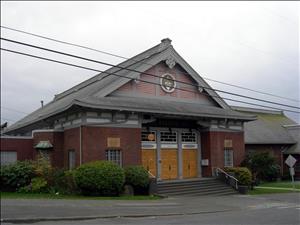On October 4, 1941, dedication ceremonies are held for the Seattle Buddhist Church, or Seattle Betsuin, a Jodo Shinshu Buddhist temple. The building, designed by architect Kichio Arai (1901-1966), is located at 1427 S Main Street. The ceremony takes place just two months before the bombing of Pearl Harbor and America's declaration of war on Japan, followed in February 1942 by President Franklin Roosevelt's (1882-1945) signing of Executive Order 9066 authorizing the confinement of West Coast Japanese citizens in internment camps. Throughout the war, the church building serves as the U.S. Maritime Commission office, but it will open again as the Seattle Buddhist Church on August 4, 1946.
Early History
The Seattle Buddhist Church follows the Jodo Shinshu tradition, a popular school of Japanese Buddhism that began in the early thirteenth century. Its first service in the Pacific Northwest was conducted in Seattle by the Rev. Kakuyro Nishijima (d. 1939) on November 15, 1901, and the local church traces its origin to that date.
The church got its start when seven young Japanese immigrant men began meeting regularly for Buddhist worship in various Seattle stores and noodle shops. As the church community grew, they commissioned architects Charles W. Saunders (1958-1935) and George Willis Lawton (1864-1928) to design a temple, which was constructed between 1906 and 1908 at 1020 Main Street. The building was torn down during construction of Seattle's Yesler Terrace housing project, which began in 1939.
A young Seattle architect, Kichio Arai (1901-1966), was commissioned to design a new temple, to be located at 1427 S Main Street. Arai's plan combined elements of traditional Japanese design with American building materials and techniques. The Japanese influence can be seen in the temple's cornices, gabled upturned eaves, and latticed entrance, while the brick façade is typically American. Since Arai did not have an architectural license at the time, Pierce A. Horrocks (1978-1942) was credited as the architect of record, with Arai as his associate.
War Years
On December 7, 1941, Japanese forces bombed the U.S. Pearl Harbor naval base and the following day the United States declared war on Japan. Japanese Americans in King County quickly responded, voicing their allegiance as citizens of the United States. James Sakamoto (1903-1955), editor of Seattle's Japanese-American Courier, spoke eloquently for local Japanese in newspaper editorials.
But on February 19, 1942, President Franklin D. Roosevelt signed Executive Order 9066, which led to the expulsion of 110,000 Japanese Americans from the West Coast and their confinement in 10 inland prison camps. In April of 1942 Japanese residents were ordered to leave Seattle. Architect Arai was most likely assigned to Camp Harmony, a Puyallup staging area for a remote camp in Idaho. By May of that year, the temple building was serving as the U.S. Maritime Commission's office, and it remained such for the war's duration.
A New Era
After the end of the war in August 1945, many Japanese residents returned to Seattle, and a group of about 600 Seattle Buddhist Church members began worshiping temporarily at 1212 King Street while they renovated their temple on S Main Street. The church was officially reopened on August 4, 1946, and has been in continuous use since that time. In November 2001 the congregation celebrated the 100th anniversary of the temple's original establishment.
The Seattle Buddhist Church is a part of Seattle's Chinatown and International District, which is on the National Register of Historic Places. The church maintains an archive, established in 1977 and reorganized in 1990, with a cataloged and indexed collection of more than 2,000 artifacts, 3,000 photographs, slides, documents, and oral-history interviews.
Among the church's yearly events is the Bon Odori summer festival, traditionally held to remember and honor dead ancestors. Bon Odori in Seattle is celebrated during Seafair each July. The event is a festival of music, dancing, food, and crafts, with a parade on Main Street. Performers have included the church-sponsored Seattle Matsuri Taiko drummers.

